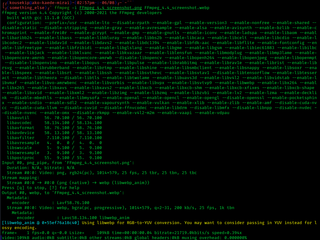A codec is a device or computer program which encodes or decodes a data stream or signal. Codec is a portmanteau of coder/decoder.
In information theory, data compression, source coding, or bit-rate reduction is the process of encoding information using fewer bits than the original representation. Any particular compression is either lossy or lossless. Lossless compression reduces bits by identifying and eliminating statistical redundancy. No information is lost in lossless compression. Lossy compression reduces bits by removing unnecessary or less important information. Typically, a device that performs data compression is referred to as an encoder, and one that performs the reversal of the process (decompression) as a decoder.
MPEG-1 is a standard for lossy compression of video and audio. It is designed to compress VHS-quality raw digital video and CD audio down to about 1.5 Mbit/s without excessive quality loss, making video CDs, digital cable/satellite TV and digital audio broadcasting (DAB) practical.

Video is an electronic medium for the recording, copying, playback, broadcasting, and display of moving visual media. Video was first developed for mechanical television systems, which were quickly replaced by cathode-ray tube (CRT) systems which, in turn, were replaced by flat panel displays of several types.
Theora is a free lossy video compression format. It is developed by the Xiph.Org Foundation and distributed without licensing fees alongside their other free and open media projects, including the Vorbis audio format and the Ogg container.
Motion JPEG is a video compression format in which each video frame or interlaced field of a digital video sequence is compressed separately as a JPEG image.

FFmpeg is a free and open-source software project consisting of a suite of libraries and programs for handling video, audio, and other multimedia files and streams. At its core is the command-line ffmpeg tool itself, designed for processing of video and audio files. It is widely used for format transcoding, basic editing, video scaling, video post-production effects and standards compliance.
RealVideo, or also spelled as Real Video is a suite of proprietary video compression formats developed by RealNetworks – the specific format changes with the version. It was first released in 1997 and as of 2008 was at version 10. RealVideo is supported on many platforms, including Windows, Mac, Linux, Solaris, and several mobile phones.
H.261 is an ITU-T video compression standard, first ratified in November 1988. It is the first member of the H.26x family of video coding standards in the domain of the ITU-T Study Group 16 Video Coding Experts Group. It was the first video coding standard that was useful in practical terms.
In video technology, 24p refers to a video format that operates at 24 frames per second frame rate with progressive scanning. Originally, 24p was used in the non-linear editing of film-originated material. Today, 24p formats are being increasingly used for aesthetic reasons in image acquisition, delivering film-like motion characteristics. Some vendors advertise 24p products as a cheaper alternative to film acquisition.
Deinterlacing is the process of converting interlaced video into a non-interlaced or progressive form. Interlaced video signals are commonly found in analog television, digital television (HDTV) when in the 1080i format, some DVD titles, and a smaller number of Blu-ray discs.
The Adaptive Multi-Rateaudio codec is an audio compression format optimized for speech coding. AMR speech codec consists of a multi-rate narrowband speech codec that encodes narrowband (200–3400 Hz) signals at variable bit rates ranging from 4.75 to 12.2 kbit/s with toll quality speech starting at 7.4 kbit/s.
An inter frame is a frame in a video compression stream which is expressed in terms of one or more neighboring frames. The "inter" part of the term refers to the use of Inter frame prediction. This kind of prediction tries to take advantage from temporal redundancy between neighboring frames enabling higher compression rates.
x264 is a free and open-source software library and a command-line utility developed by VideoLAN for encoding video streams into the H.264/MPEG-4 AVC video coding format. It is released under the terms of the GNU General Public License.

Avidemux is a free and open-source software application for non-linear video editing and transcoding multimedia files. The developers intend it as "a simple tool for simple video processing tasks" and to allow users "to do elementary things in a very straightforward way". It is written in C++ and uses Qt for its graphical user interface, and FFmpeg for its multimedia functions. Starting with version 2.4, Avidemux also offers a command-line interface, and since version 2.6, the original GTK port has not been maintained and is now discontinued.
libavcodec is a free and open-source library of codecs for encoding and decoding video and audio data.
Α video codec is software or a device that provides encoding and decoding for digital video, and which may or may not include the use of video compression and/or decompression. Most codecs are typically implementations of video coding formats.
Media Foundation (MF) is a COM-based multimedia framework pipeline and infrastructure platform for digital media in Windows Vista, Windows 7, Windows 8, Windows 8.1, Windows 10, and Windows 11. It is the intended replacement for Microsoft DirectShow, Windows Media SDK, DirectX Media Objects (DMOs) and all other so-called "legacy" multimedia APIs such as Audio Compression Manager (ACM) and Video for Windows (VfW). The existing DirectShow technology is intended to be replaced by Media Foundation step-by-step, starting with a few features. For some time there will be a co-existence of Media Foundation and DirectShow. Media Foundation will not be available for previous Windows versions, including Windows XP.
The following is a list of H.264/MPEG-4 AVC products and implementations.
A video coding format is a content representation format for storage or transmission of digital video content. It typically uses a standardized video compression algorithm, most commonly based on discrete cosine transform (DCT) coding and motion compensation. A specific software, firmware, or hardware implementation capable of compression or decompression to/from a specific video coding format is called a video codec.


